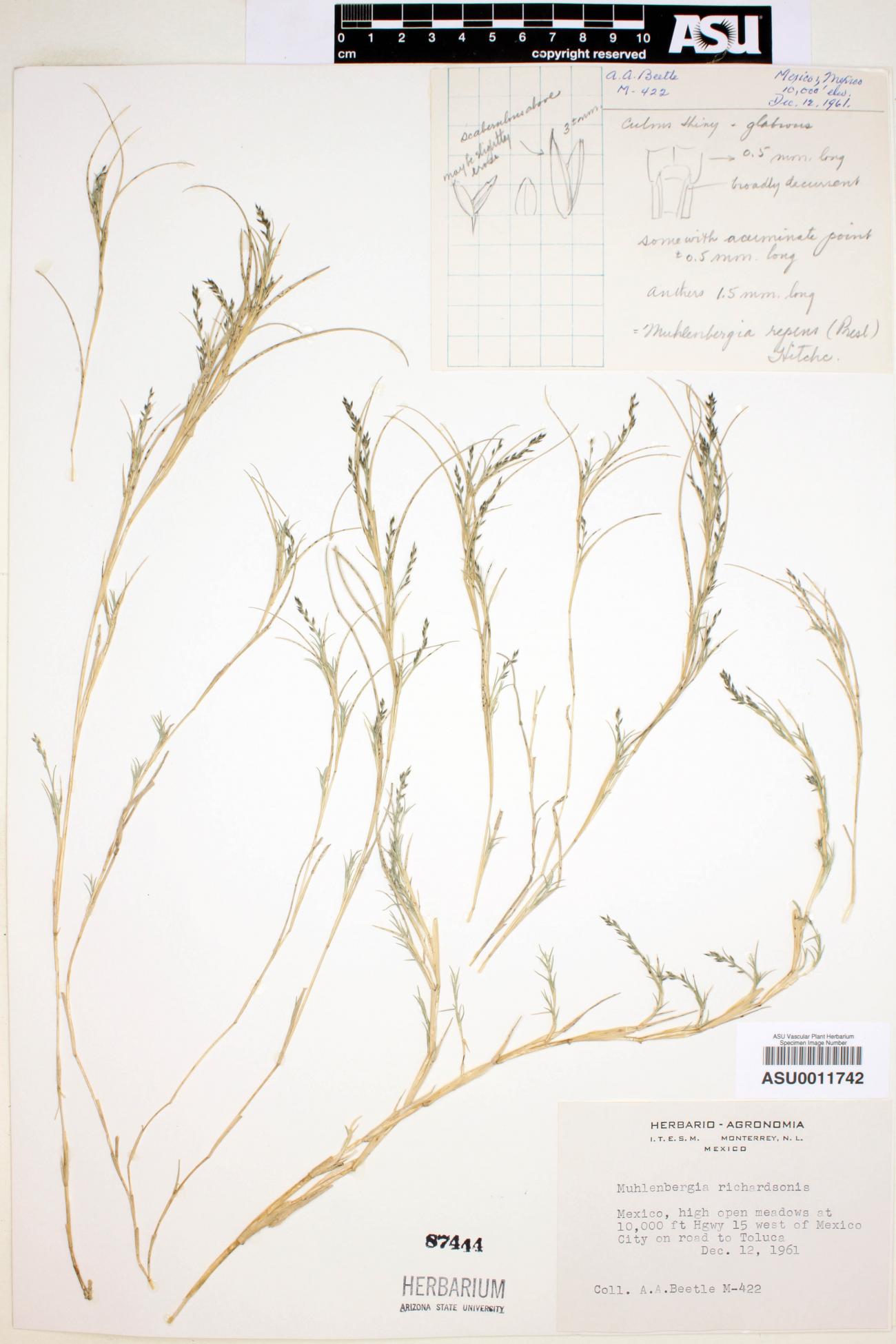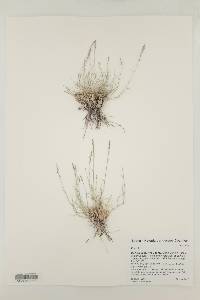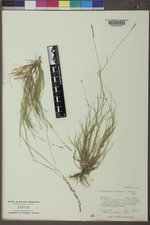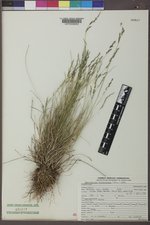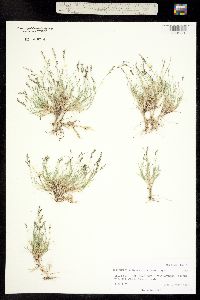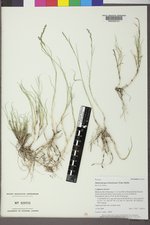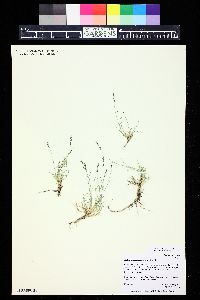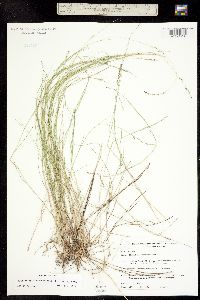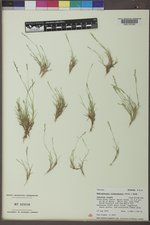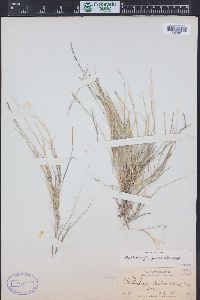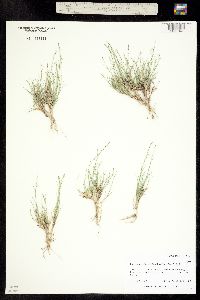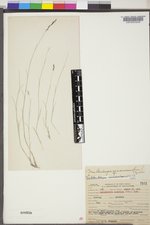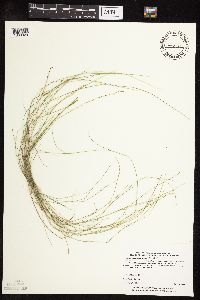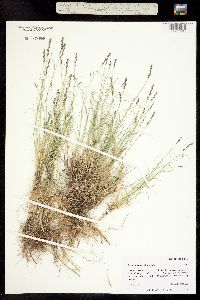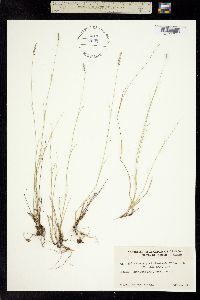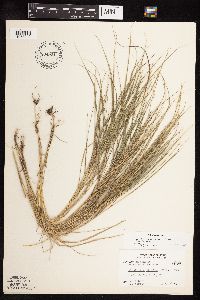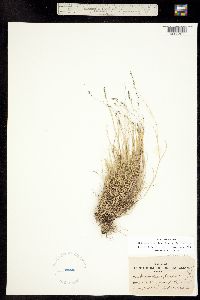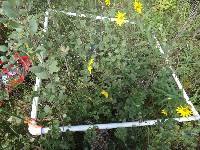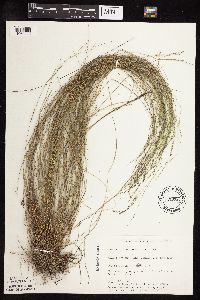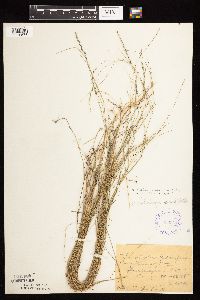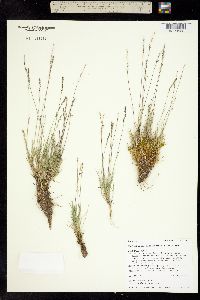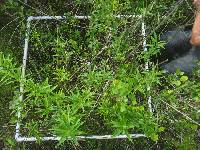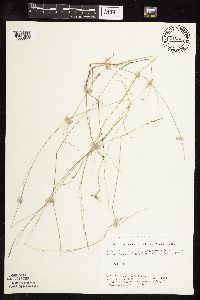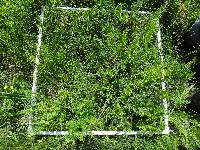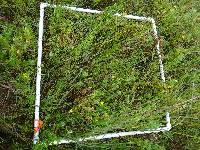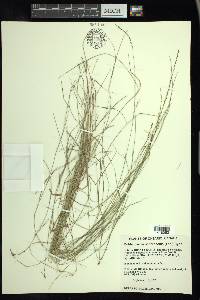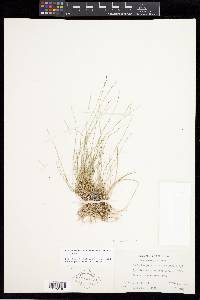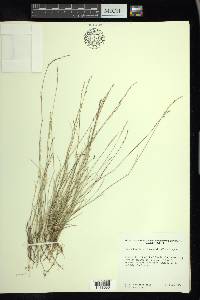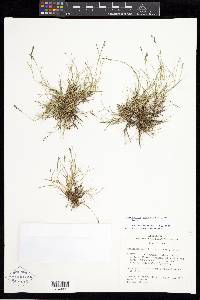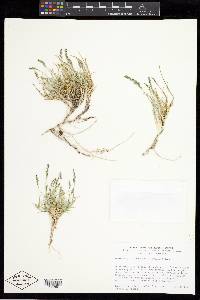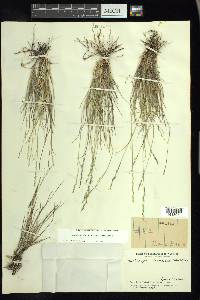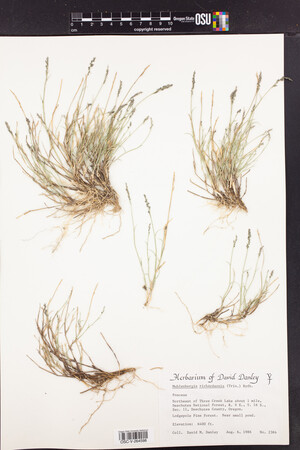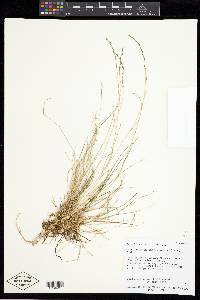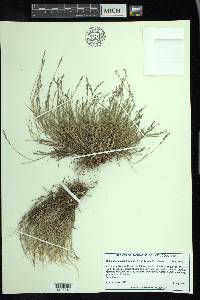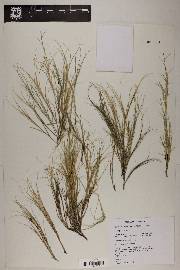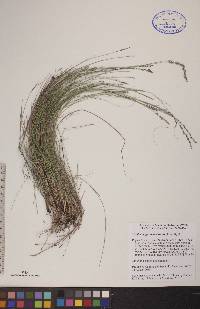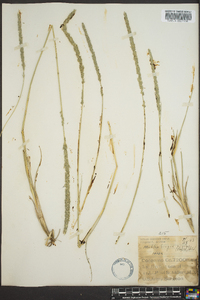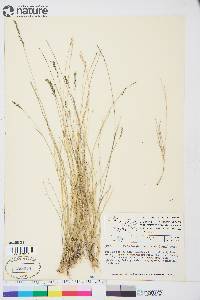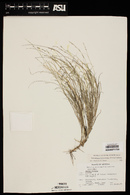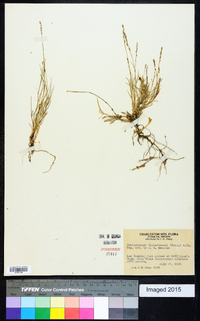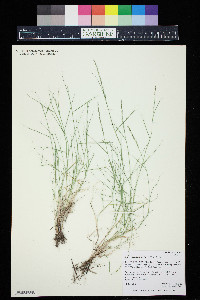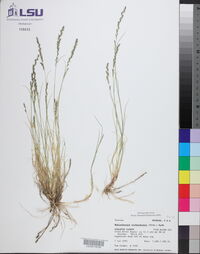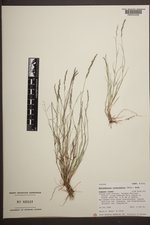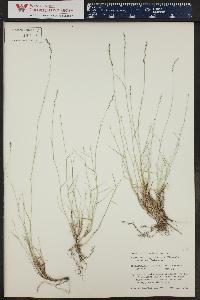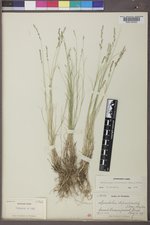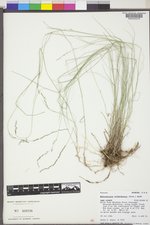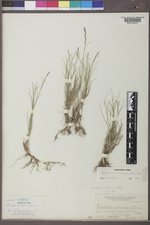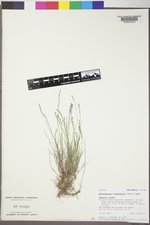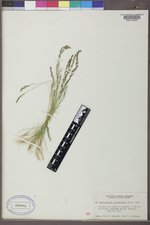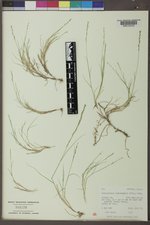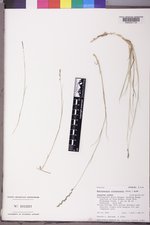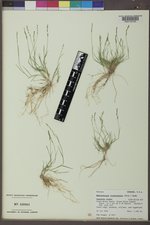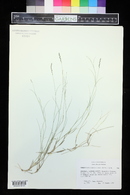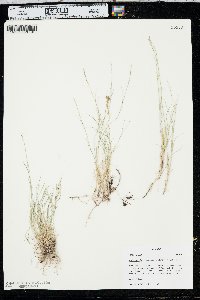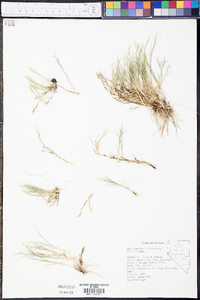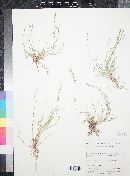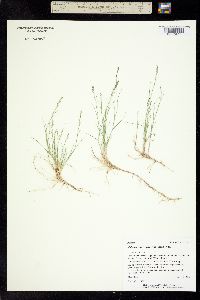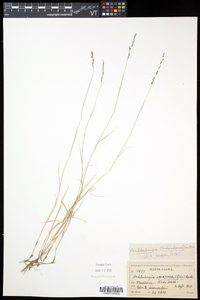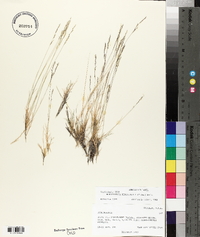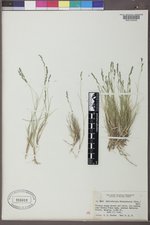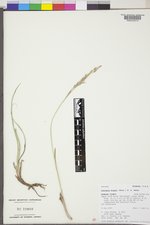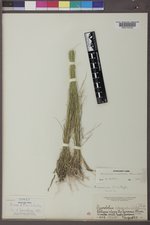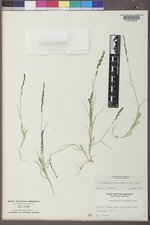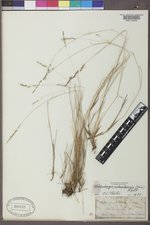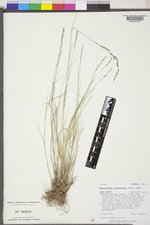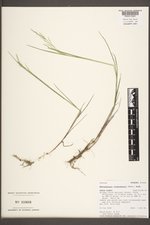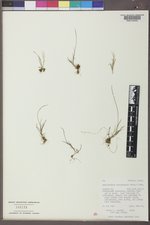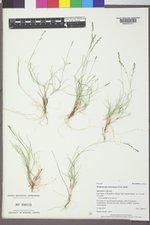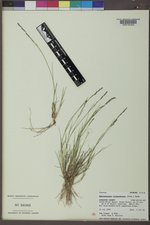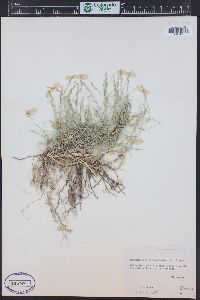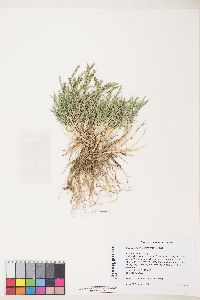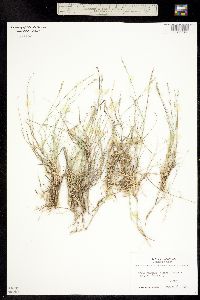
|
|
|
|
Family: Poaceae
mat muhly, more...Matted Muhly, Muhlenbergie de Richardson
[Muhlenbergia aspericaulis Nees ex Trin., moreMuhlenbergia brevifolia var. richardsonis (Trin.) M.E. Jones, Muhlenbergia squarrosa (Trin.) Rydb., Sporobolus aspericaulis Scribn., Sporobolus depauperatus , Sporobolus richardsonis (Trin.) Merr., Vilfa depauperata Torr. ex Hook., Vilfa richardsonis Trin., Vilfa squarrosa Trin.] |
Plants perennial; rhizomatous, not cespitose, often mat-forming. Culms 5-30 cm tall, 0.4-1 mm thick, decumbent, geniculate, or erect; internodes usually nodulose (occasionally smooth) for most of their length, puberulent or nodulose below the nodes. Sheaths shorter or longer than the internodes, glabrous; ligules 0.8-3 mm, membranous, acute to truncate, erose; blades 0.4-6.5 cm long, 0.5-4.2 mm wide, flat or involute, straight or arcuate-spreading, glabrous abaxially, hirtellous adaxially. Panicles 1-15 cm long, 0.1-1.7 cm wide, exserted, narrow or spikelike, rachises usually concealed by the branches; primary branches 0.4-5 cm, usually closely appressed at maturity, rarely diverging up to 20° from the rachises; pedicels 0.2-2 mm, setulose. Spikelets 1.7-3.1 mm, occasionally with 2 florets. Glumes subequal, 0.6-2 mm, 1/3-1/2 as long as the lemmas, green, 1(2)-veined, acute, sometimes mucronate, mucros less than 0.2 mm; lemmas 1.7-2.6(3.1) mm, lanceolate, dark greenish, plumbeous, or mottled, glabrous, apices scabridulous, acute to acuminate, sometimes mucronate, mucros to 0.5 mm; paleas 1.2-2.4(2.9) mm, lanceolate, acute; anthers 0.9-1.6 mm, yellow to purplish. Caryopses 0.9-1.6 mm, narrowly ellipsoid, brown. 2n = 40. Muhlenbergia richardsonis grows in open sites in alkaline meadows, prairies, sandy arroyo bottoms, talus slopes, rocky flats and the shores of rivers, at elevations of 60-3300 m. It is the most widespread species of Muhlenbergia in the Flora region, extending from the Yukon Territory to Quebec in the north and to northern Baja California, Mexico, in the south. Morden and Hatch (1996) reported that it also grows in Alaska, but no voucher specimen has been located. Muhlenbergia richardsonis is often confused with M. cuspidata, which differs in lacking rhizomes and having shorter ligules, and sometimes with M. filiformis, which differs in being a weak annual with glabrous internodes and obtuse, erose glumes. FNA 2003, Gould 1980 Common Name: mat muhly Duration: Perennial Nativity: Native Lifeform: Graminoid General: Rhizomatous perennial, often mat forming with stems erect or slightly decumbent to geniculate at base, 5-30 cm tall, 0.5-1 mm thick, spreading from a common crown, internodes roughened, puberulent below the nodes, sheaths glabrous. Vegetative: Blades 0.5-6.5 cm long, 0.5-4.5 mm wide, flat or involute, glabrous below, hirtellous above, ligules 0.8-3 mm, membranous, acute to truncate, erose. Inflorescence: Narrow or spikelike panicles 1-15 cm long, 0.1-1.7 cm wide, dark green, exserted, rachises usually concealed by the branches, primary branches 0.5-5 cm, closely appressed at maturity, rarely more than 20 degrees divergent from the rachises, with spikelets 1.5-3 mm, occasionally with 2 florets, dark green to blackish hue; glumes subequal, 0.5-2 mm, one third to half as long as lemmas, green, 1-veined, acute, sometimes mucronate with mucros less than 0.2 mm; lemmas 1.5-2.5 mm, lanceolate, dark greenish, mottled, apices minutely roughened, acute to acuminate, sometimes mucronate with mucros to 0.5 mm. Ecology: Found in alkaline meadows, sandy arroyo bottoms, on talus slopes, rocky flats and along creeks from 6,500-11,000 ft (1981-3353 m); flowers July-September. Notes: Uncertain if this species is found at Gila Cliff Dwellings. Similar in appearance to M. repens but the blades are not as tightly clumped. Ethnobotany: Used as a horse medicine. Etymology: Muhlenbergia is named for Gotthilf Heinrich Ernst Muhlenberg (1753-1815) a clergyman and botanist from Pennsylvania; richardsonis is named for Sir John Richardson (1787-1865) a Scottish naturalist and explorer. Synonyms: Muhlenbergia squarrosa Editor: SBuckley, 2010 Culms clustered, 3-6 dm, very slender and wiry, minutely roughened at the nodes, erect or often decumbent and rooting near the base, forming mats, but the plant without rhizomes; ligule 1.5-3 mm; blades usually involute, 1-2 mm wide, erect or ascending, the main ones 3-6 cm; panicles 1-4(-7) cm, slender, with short, ascending, scarcely overlapping branches; glumes lance-ovate, glabrous, the first 0.9-1.3 mm, the second 1-1.5 mm; lemma glabrous, obscurely veined, 2-3.3 mm, tapering to a subulate point; 2n=40. Wet gravelly soil; Anticosti I. to Me.; s. Mich.; Minn. to Wash. and N.M. Gleason, Henry A. & Cronquist, Arthur J. 1991. Manual of vascular plants of northeastern United States and adjacent Canada. lxxv + 910 pp. ©The New York Botanical Garden. All rights reserved. Used by permission. |

